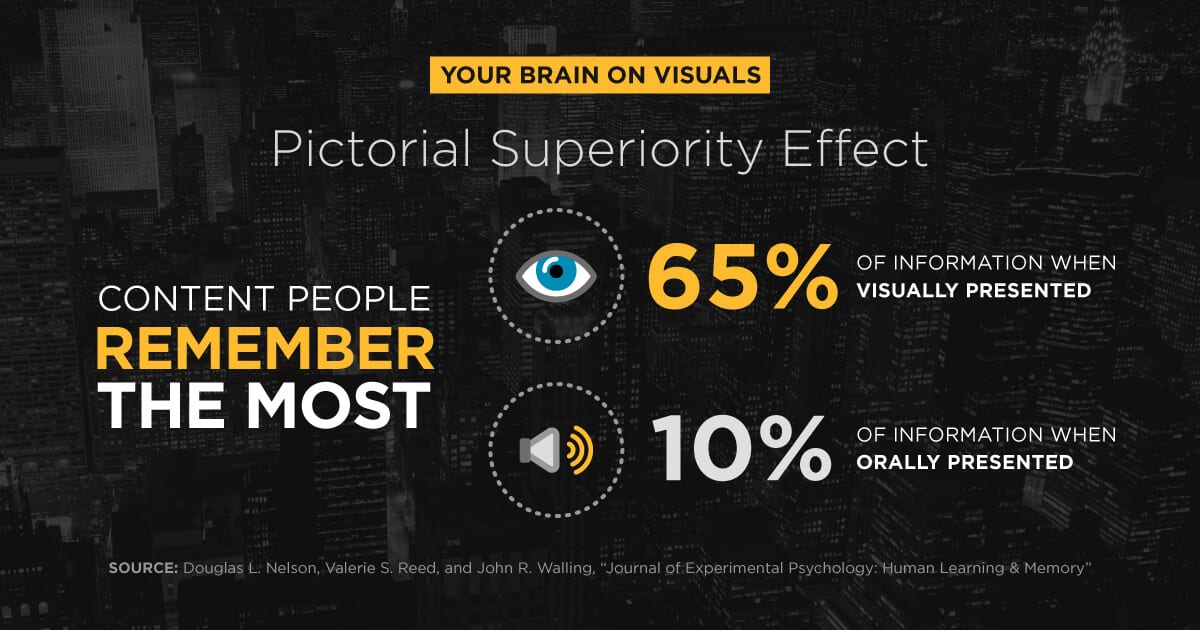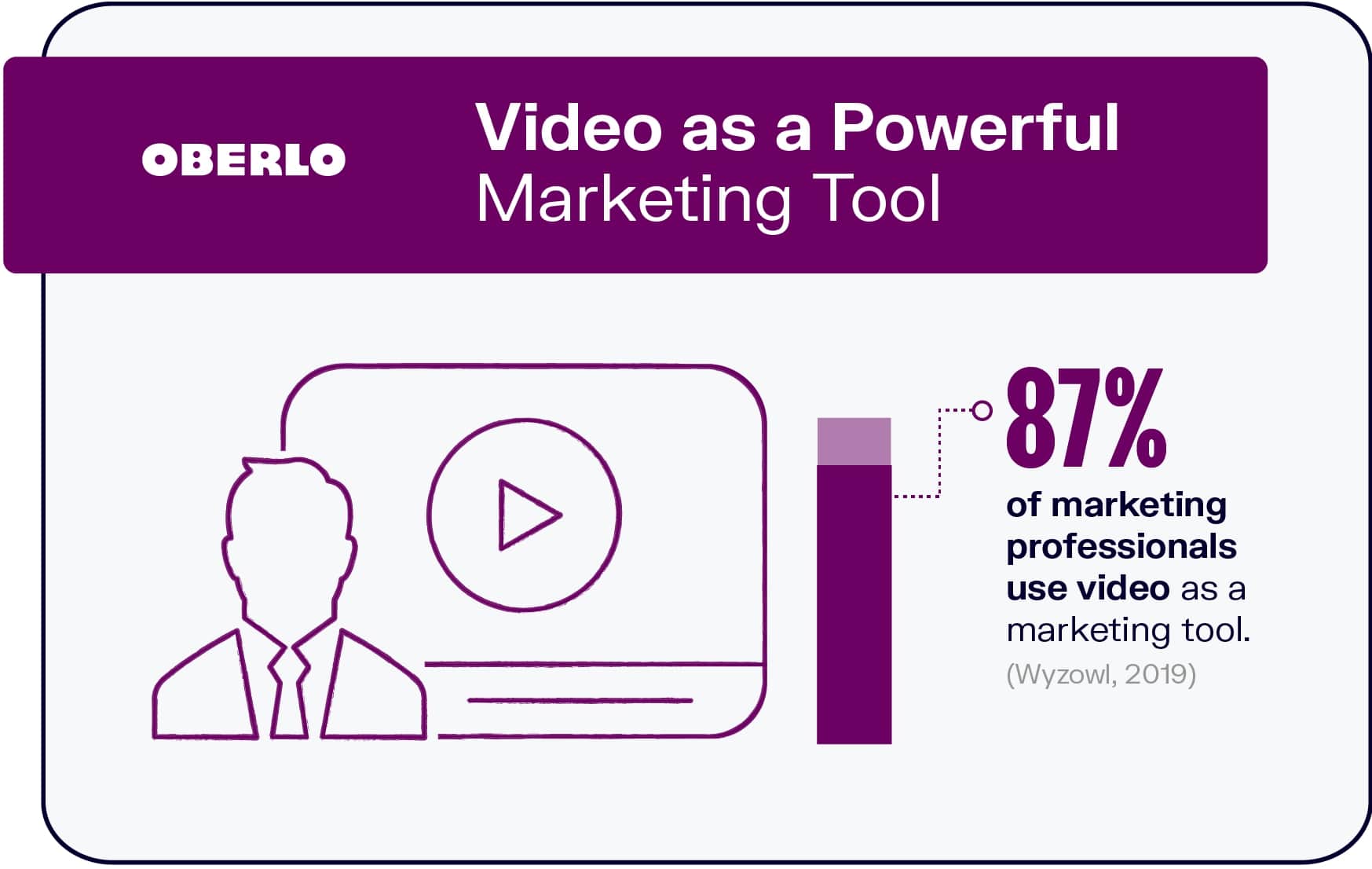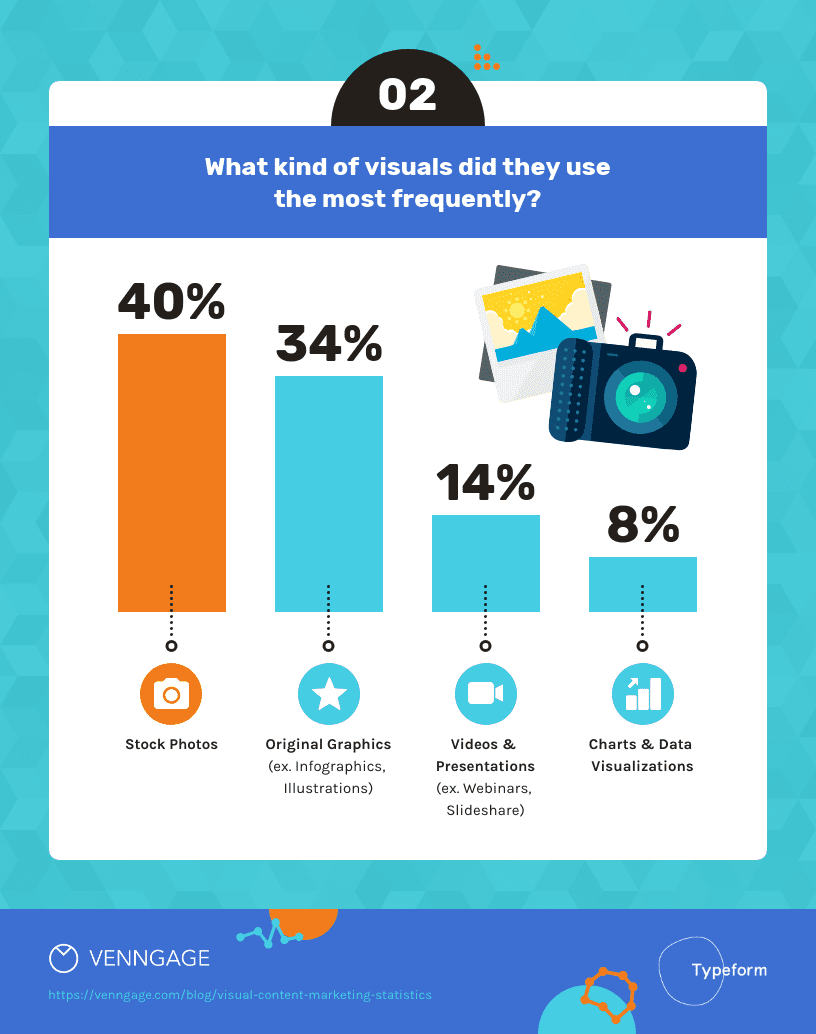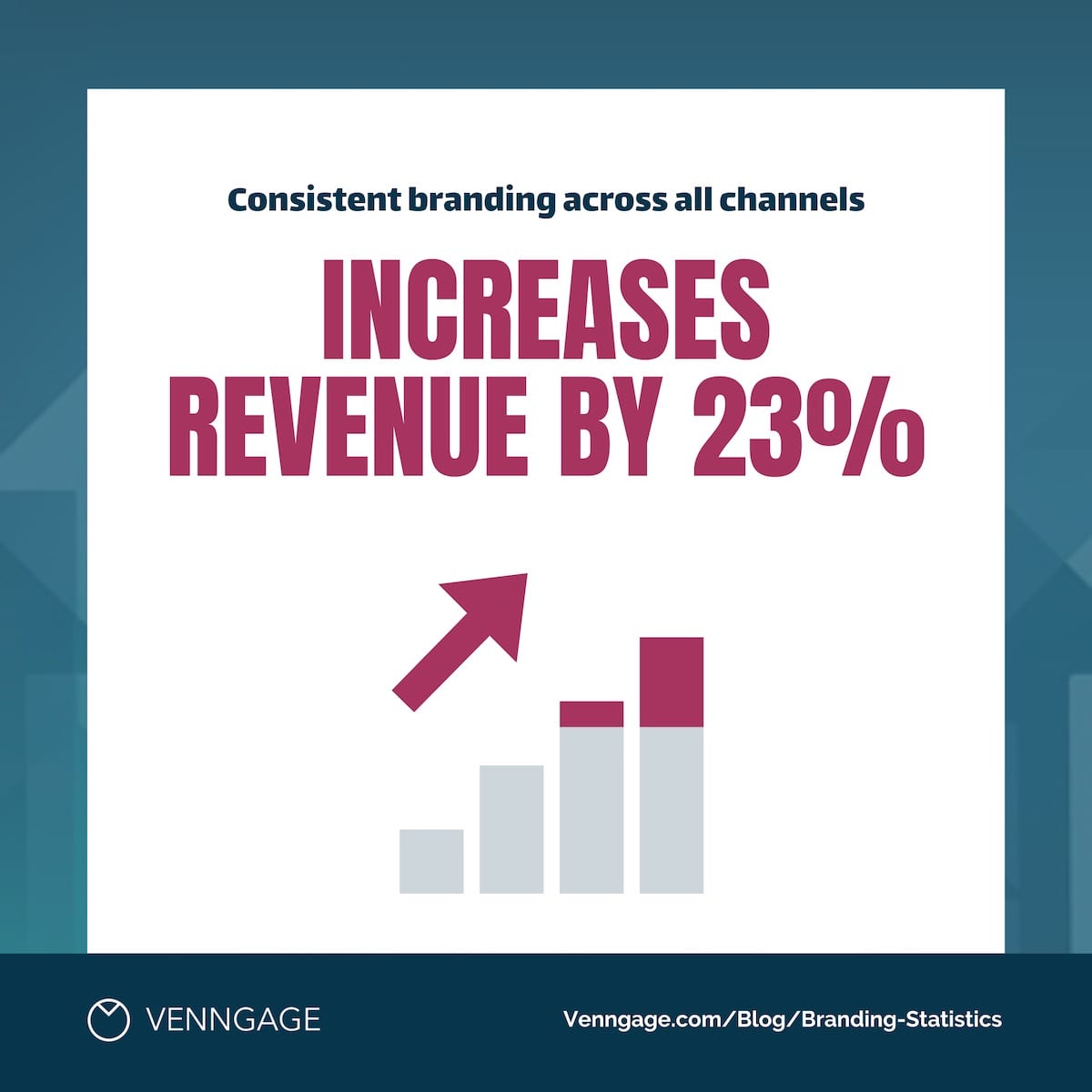7 Powerful Ways to Implement Visual Content in Your Marketing Strategy
Content plays a huge role in marketing. Research shows that 91% of B2B marketers and 86% of B2C marketers consider content marketing critical in reaching their target audience. If you’re a savvy marketer who understands the effectiveness of inbound marketing, content must play a central role in your marketing.
But with so much written content out there, the competition to stand out becomes stiffer by the day.
And that’s where visual content comes to play.
What is Visual Content (And Why is it Important)?
As the name suggests, visual content refers to any type of content that is image-based. This spans the gamut from photos and images to videos.
Why should you bother with visual content in your marketing strategy?
Apart from the fact that 86% of businesses predict that visuals will be an essential part of their content strategy in 2021, here are a few other reasons:
- Grab attention
- Increase engagement rates
- Help you connect with your audience on an emotional level
- Are interactive
- Have a higher potential of going viral on social media
Add to all this the fact that our brains remember visual content 6X better than written or spoken content, and visuals are a marketing medium you just can’t ignore. If you want to create content that moves your marketing needle north, you must implement visual content into your marketing strategy.
7 Ways to Implement Visual Content in Your Marketing Strategy
Having seen the impact that visual content can have, let’s quickly examine how you can use them in your marketing strategy.
1. Video (Live and Recorded)
In a study conducted by Hubspot, 54% of consumers cited video as their favorite content format. One reason video is a much-loved content format is the way it offers viewers an immersive experience.
So how can you use video in your content marketing?
Here are a few examples:
- Use video testimonials and reviews
- Create product explainer videos
- Use webinars as a lead generation tool
While videos may cost more than other visual content types, there are cost-effective ways to get quality videos done. Brands can create explainer videos using screen recording software or simple animation tools that allow you to create storyboards and add voiceover audio in a few clicks. If you want to create more elaborate cinematographic productions, you can also use low-cost software to edit YouTube videos to add a professional touch. Either way, the options to create quality videos is worth the time and investment. Especially considering a report from Wyzowl revealed that 87% of video marketers saw an increase in traffic to their sites thanks to video. What’s more, 89% say video gives them a good ROI.
2. Infographics
The word “infographic” is a combination of two words – information and graphic. Therefore, an infographic is a communication medium that features the use of graphics and text to convey a message. Approximately 84% of content creators who use infographics in their marketing strategy rate them as being highly effective at creating engagement because they appeal to a wider audience – thanks to their being easy to understand.
Using infographics in marketing campaigns is a no brainer. A few ways to do so include:
- Share them on social media to boost brand awareness
- Use them to generate backlinks
- Drive traffic to your website (can increase site traffic by 12%)
The key to creating effective infographics is to include a lot of data and couple it to power words that trigger an emotional response from your audience. All this, of course, on the backdrop of your beautiful graphics.
3. Memes and Gifs
Memes and Gifs are famous for the laughs they bring. But laughter is not the only thing you can derive from these visual content types. Brands enjoy more ROIs from meme accounts than from influencer marketing campaigns, making meme accounts the new influencer marketing.
Let’s backtrack a bit and look at what these two similar content types are.
- Meme. An image or short video that portrays a particular concept (usually in a humorous way) and is spread via social sites on the internet.
- GIFs. This is a file image that can play short animation like videos. While this file format is ancient (created in 1987) it is one of the most popular file types around.
One reason memes and GIFs are so popular is that they easily communicate information and emotions, a key ingredient in marketing.
But how do you use them in marketing?
The primary way to use memes and GIFs in your marketing is to use them as part of your social media marketing. This helps with your brand awareness, thanks to their high share rates. They are also great for making light of customer service, which plays a huge role in customer experience (CX).
4. Photos and Illustrations
Photos and illustrations have been used to communicate offline and online for many years. Yet their impact has not waned. That’s because this type of visual content has a special way of tugging at heartstrings. Even if you’re just starting out in business and don’t have the budget for custom photographs or illustrations, you can always use royalty free ones.
Wondering how to use images in your marketing campaigns?
- Add them to blog posts to increase engagement
- Use them as visual cues to point to important sections of your written content (like a CTA)
- Make “eye contact” with your audience through photos
- Use illustrations to, well, illustrate a point
Though old school, photos still pack a punch in content marketing. So don’t hesitate to use them.
5. Screenshots
Especially in B2B marketing, education plays a huge role in converting prospects into customers. While you may not have your prospects in the same room with you to show them crucial steps to using your service/product, you can achieve the same effect using screenshots. That’s especially if you use a powerful screenshot and annotation tool like Markup Hero.
Showing what your product/service can do (using screenshots) is a great way to build trust, especially when marketing to mid-funnel prospects. As for how to use screenshots in your marketing, here are a few ways to do so:
- Include them in educational material like eBooks, blog posts
- Capture customer reviews and testimonials and share them on social media or your emails
While screenshots may seem to be the least sexy visual content type, used well, they can be a powerful tool for encouraging conversions.
6. Charts and Graphs
Charts and graphs usually work best in B2B marketing, where you need to appeal to your audience’s logic more than their emotions. Because they convey important facts and data in a simpler way, they’re easy to digest, making them the perfect medium for communicating with busy B2B buyers. Research shows that data-driven visuals rank fourth in types of content that are most shared.
How do you integrate charts and graphs into your visual content marketing strategy?
- Include them in written content to amplify your message
- Use downloadable charts and graphs for lead generation
- Can boost brand awareness if created in a shareable format such as a pin for Pinterest
- Great way to build backlinks and drive traffic to your website
Sure, graphs and charts may be geeky, but they positively impact your marketing campaigns.
7. Flip Books
A flip book is a magazine that is published online. And like its traditional print counterpart, it’s image-heavy. Flip books have become popular over the years, especially in B2C circles, as they are attractive, user-friendly, and engaging. Use cases for them in marketing include:
- Lead magnet to drive email signups
- Product catalog that you can embed in your blog posts
- Great for brand awareness as they are easily shareable
If flip books are not yet part of your marketing arsenal, make sure to quickly get a great designer and create some for your next campaign.
5 Best Practices for Implementing Visual Content in Your Marketing Strategy
You’ve seen the value of visuals in your marketing strategy and how to use them. Now let’s briefly look at some best practices to follow to get the best out of your visual content.
1. Understand Your Audience
Know what kind of visuals your audience loves and give them just that. Yes, it’s your brand creating the visual content to achieve its goals, but your audience must determine the kind of visual content you create.
That’s why you need a deep understanding of your audience. It will save you the heartache of spending on visuals that don’t produce results.
2. Maintain Brand Consistency
When creating visuals, one of the biggest temptations is to go all out in creating the best visuals on the internet. While this is fair and fine, the danger is that you may end up losing brand consistency. This may result in poor brand recognition. With studies showing that consistent branding across all channels increases revenue by as much as 23%, this is something you can’t ignore. Leverage social media scheduling tools to manage your message across all of your social platforms.
3. Get Your Customers to Help
If there’s one thing people want from a brand is authenticity. One way you can be authentic in your marketing is by asking your customers to help you with your content creation. This is called user generated content (UCG) and helps boost authenticity. More than that, it humanizes your brand, making your business more approachable. That’s probably why 53% of millennials say UGC influences their purchase decisions.
4. Every Visual Must Serve a Purpose
Never make the mistake of creating visuals just for the sake of beautifying your content. Every visual must serve a purpose. It must either help clarify your message or tell a story that connects readers to your brand/message.
5. Allow Data to Guide You
Data-driven marketing has been proven to increase the ROI on campaigns 5-8X. Just like all your marketing strategies, data must be the fuel behind your visual content. Track and analyse the kind of visual content that drives more engagement and has more ROI. Once you’ve identified them, focus more resources in creating them.
Visual Content – The Key to a Winning Marketing Strategy
Remember, people are 90% visual learners. Because human beings are visual learners, visual content must play a prominent role in your marketing. It will help your brand stick in your customers’ minds as well as encourage conversions.



 Image Source
Image Source Image Source
Image Source Image Source
Image Source






